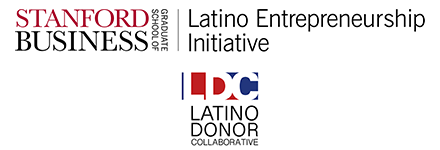At a Glance
- Latinos are a growing, youthful, and highly productive cohort that will drive future US economic and population growth—and Latino-owned businesses (LOBs) are an overlooked investment opportunity.
- Despite their enormous importance to the economy, LOBs are underfunded across all sources of capital.
- This is a clear opportunity for equity investors and LOBs. LOBs need equity investment so that they can direct cash flow to growth. Angels, venture capital, private equity and other equity sources can serve this unmet need with an expectation of high returns.
- LOBs appear to struggle with a “scale wall” at around $1 million in revenue, at which point high-cost debt and a lack of equity investments may pose significant challenges in reinvesting cash to scale.
- LOBs are not monolithic: Six distinct segments need equitable evaluations, new products, and enhanced awareness of funding options, offering opportunities for institutional investors of all types.
Latino-owned businesses (LOBs) are an overlooked opportunity in the current US economy. The total economic output of US Latinos was $2.7 trillion in 2019, making US Latinos the equivalent of the seventh-largest economy in the world. Latinos are a rapidly growing cohort, with the US Latino population surpassing 60 million in 2019 and set to double over the next four decades. This growth is driven, in part, by their younger age structure. Latinos have a median age of 30, compared with the white population’s median age of 44. Latinos accounted for 82% of growth in US labor force participation from 2010 to 2017 despite representing less than 19% of the total US population. And this growing, young, and productive Latino cohort is funding an increasing share of our financial system, with the median Latino retirement account achieving a compound annual growth rate (CAGR) of 9% between 2013 and 2019, compared with zero growth for all families in the US, according to the US Survey of Consumer Finances.
annual contribution to the US economy by Latinos (as of 2019)
Latino entrepreneurs fuel the US economic engine in many ways. They have been responsible for approximately 50% of net new small business growth over the past decade (2007–2017). According to the latest data from the Stanford Latino Entrepreneurship Initiative (SLEI), Latino-owned businesses are high-quality businesses and highly worthy of investment. LOBs are growing in annual revenue faster than white-owned businesses (WOBs), at 10% compared with 7% for WOBs, and they are 11 percentage points more likely to have a healthy business credit score above 680.
Employment among Latino-owned businesses grew 2x faster than non-Latino-owned businesses (from 2014 to 2016)
And these LOBs are creating jobs in the process. Employment among LOBs grew two times faster than non-LOBs between 2014 and 2016. By 2026, 13% of employer LOBs expect to have 100 or more employees compared with just 8% of employer WOBs, according to the SLEI annual survey of employer businesses.
Produced with research support from

And yet there is a serious problem that prevents LOBs from reaching their full potential. In spite of their rapid growth, Latino-owned businesses are not getting their fair share of capital from the investment community. Without the ability to seek equity for growth or affordably priced debt from banks, LOBs remain significantly underfunded compared with similar WOBs, limiting their ability to scale. But if today’s LOB population were equitably funded with non-Latino WOBs, they could generate $1.4 trillion in additional revenue today and $3.3 trillion in additional revenue by 2030, according to Bain research, and corroborated by SLEI.
The root of the problem isn’t the investment potential of LOBs. Compared with their white-owned peers, LOBs outpace WOB revenue growth at every business size. Instead, the structures that exist today appear to systemically underfund these businesses. In fact, according to our research, less than 1% of funds from today's top VC and PE investors wind up in the hands of Latino-owned businesses. In addition, the data suggests that LOBs need to enroll twice as many investors as WOBs to get the same level of funding, and mature employer LOBs are 30 to 50 percentage points less likely to have funding needs fully met by angel investors.
Equity investment from angels, small private investors, VC, and PE is a critical enabler of growth for businesses—but Latinos are significantly underrepresented in today’s equity investment landscape.
Equity investment from angels, small private investors, VC, and PE is a critical enabler of growth for businesses—but Latinos are significantly underrepresented in today’s equity investment landscape. By selling a portion of the business, owners get capital to address immediate needs and scale. Unlike debt, equity investments do not require using immediate cash flow for repayments, so cash can be directed toward growth. Access to equity investment enables business owners to reinvest cash into business growth, as well as to tap into expertise and connections that can help them succeed.
Latinos are playing an important role in providing the funding that eventually reaches VC and PE in the financial landscape, but they are largely absent on the receiving end of the supply chain. The pension funds the Latino community pays into are allocating increasing amounts to VC and PE, growing alternative investments from 11% of allocations in 2006 to 26% of allocations in 2016. Roughly 46% of PE funds came from pension funds in 2020—but these funds do not make their way back to Latino-owned businesses.
This broken flow of capital results in a persistent underfunding of LOBs, which can be seen most clearly as LOBs approach the $1 million revenue mark. At this stage, these businesses appear to start to struggle with profitability and cash flow, which makes it harder to scale. In this critical window, LOB growth decelerates while WOB growth accelerates, closing the gap in annual growth to just 1 percentage point (see Figure 1). If they manage to push through that barrier, the few LOBs that do break through the $5 million revenue mark grow at a rate almost double the rate of WOBs.
Latino-owned business revenue growth outpaces that of white-owned businesses, but the gap narrows at $1 million

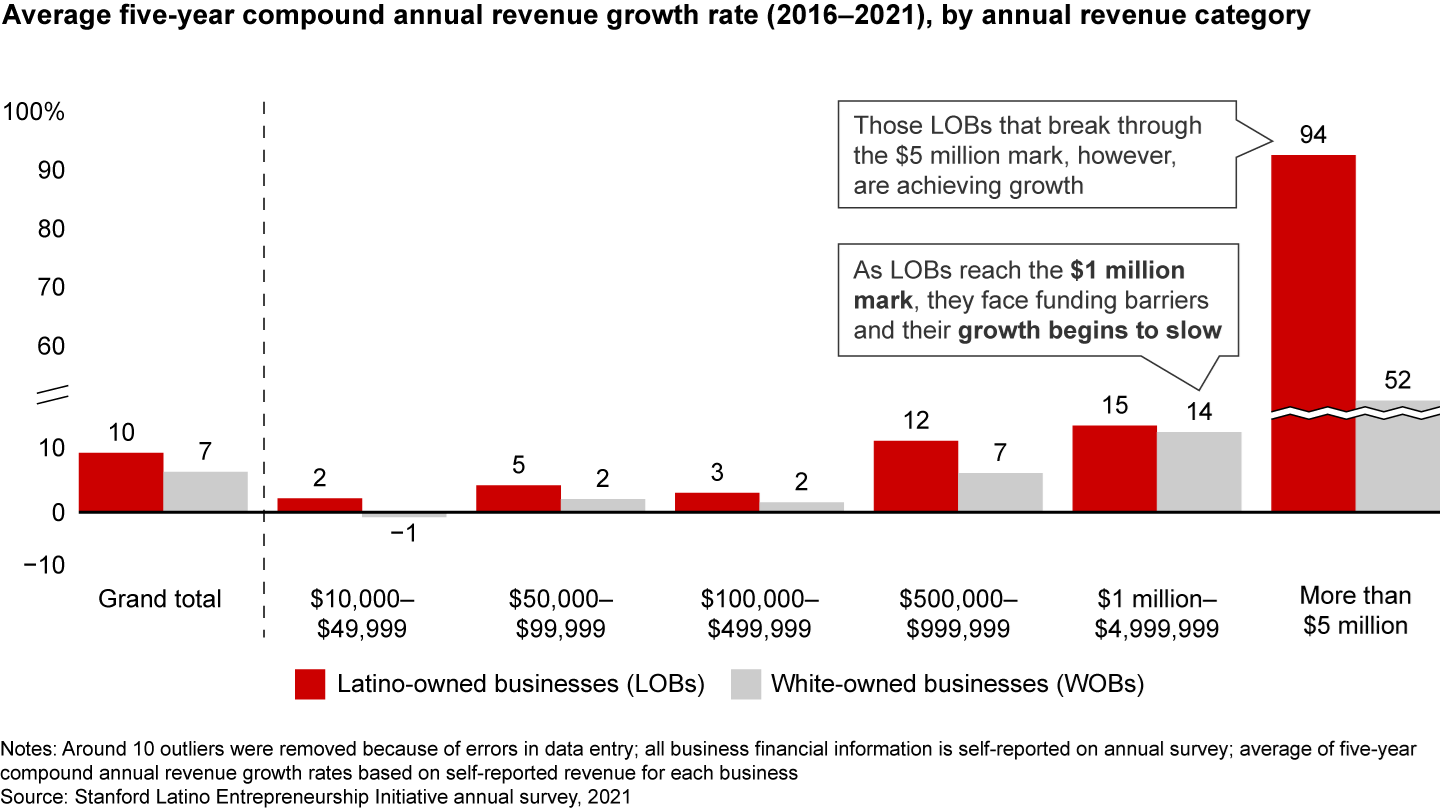
LOBs at this threshold need access to affordable capital and equity investments; they need a pathway to sustainable growth that unlocks scale and real wealth creation. But that pathway is not available to most LOBs right now.
The seeds for this $1 million barrier are planted early for most LOBs. Even though these businesses grow revenue faster than their white-owned peers, they struggle to get capital from traditional sources from their earliest stages of growth. They don’t have easy access to early-stage equity investments, and they face lower rates of approval and funding from banks. This sets a vicious cycle in motion, forcing LOBs to turn to expensive forms of debt, including hard-money lending, and creating challenges with cash flow, profitability, and obtaining later equity investments as these businesses seek to scale.
At the $1 million revenue mark, just as businesses need a capital infusion to scale, LOBs face a Darwinian survival test that their white-owned peers do not face nearly as often.
The traditional supply chain of capitalism, in which promising growth opportunities are nourished by access to capital, is broken for LOBs. At the $1 million revenue mark, just as businesses need a capital infusion to scale, LOBs face a Darwinian survival test that their white-owned peers do not face nearly as often. Do they go for aggressive growth by taking on high-interest funding, given lack of access to equity investments, in order to scale? Or should they settle for what they have already achieved over losing what they have worked so hard to build? The choice may be even more difficult considering that so many LOB entrepreneurs have bootstrapped businesses from lower socioeconomic backgrounds, risking personal assets to reach this point. Those few LOBs who make it to the $5 million mark are strong businesses with strong average growth trajectories, but too many high-potential businesses are forced to manage for cash and settle.
There are clear solutions to the funding challenges LOBs face, and the time has come for both equity and debt investors to take action. Given that around 70% of actively managed funds are held by the top 25 players, these firms will be critical to the solution. These players can either directly invest in LOBs through their own funds, or they can help cultivate funds to specifically target LOBs. But all providers of capital have a role to play. Banks, for example, can make it easier for LOBs to be approved for loans with more equitable criteria that take into account how LOBs typically grow. Banks can also establish relay partnerships with community development financial institutions (CDFIs) to help LOBs professionalize to become more worthy creditors while simultaneously raising LOB awareness of funding availability. Both banks and CDFIs can provide wraparound services, including training, consulting, and software support to help LOBs learn the ropes faster and to make it easier to assess and partner on funding.
A growing community of LOB-focused investors have already seen the opportunity and the challenge. Camino Financial, Founders First, LiftFund, and other players focus their investments on LOBs of all sizes. This group encompasses both debt and equity, as well as CDFIs and for-profit investors, which see strong potential in LOBs to realize returns and drive impact in parallel. But today’s efforts are not at the scale needed to match the growing role Latinos play in our financial system. LOBs need greater access to low-cost capital, particularly in the form of early equity investments, to give these businesses a fair shot at growth.
No single approach to solving this problem will work, however. LOBs aren’t all the same. Size is the most important variable for understanding LOB capital needs, but across sizes, there are distinct needs, behaviors, and levels of awareness. So Bain has collaborated with SLEI to better understand the current topography of LOBs in the US to help drive awareness of distinct LOB segment characteristics and funding needs. It is our hope that this segmentation will help financial institutions and other investors develop appropriate products and strategies—and raise awareness among LOBs—to help close the funding gap and finally unleash the full potential of LOB growth in the economy.
Latinos are growing quickly in population size—and economic output
It’s no secret that the Latino population is growing rapidly in the US, surpassing 60 million in 2019. The Latino population is projected to nearly double over the next four decades. As the white population ages (median age: 44), the growing, younger Latino population (median age: 30) will comprise a larger share of total population and have an outsized influence on the labor market. One million Latinos will turn 18 this year—and every year for the next 20. The Latino population already has an above-average labor force participation rate compared with non-Latino groups, and Latinos are projected to account for 80% of the total growth in the US labor force between 2010 and 2050.
But what often goes less noticed is just how significant the Latino population has become to the US economy. Among the largest fully developed economies in the world, US Latino gross domestic product (GDP) is the fastest-growing “economy,” and grew 28% faster than the rest of the US economy from 2010 to 2017.
These data points only begin to tell the story of the influence of Latinos on the US economy. Latinos are a uniquely productive, growing, and young cohort in the US. At a time when the number of business start-ups is decreasing among white males, entrepreneurship among Latinos is on the rise, according to the 2015 Kauffman Index of Startup Activity National Trends. That makes the contribution of Latinos to the US more significant than ever before. While Latinos currently represent less than 19% of the total US population (according to the 2020 US Census), they are punching above their weight in starting and growing small businesses.
Small businesses are the engine of the US economy, collectively accounting for approximately 44% of GDP and approximately 67% of US jobs. LOBs represent an extraordinarily entrepreneurial segment of the US population; approximately 50% of net new small businesses are started by Latinos. They are not only starting but also sustaining new employer businesses, with an average self-reported CAGR of 10% over the past five years (compared with just 7% from their white-owned peers), according to Bain analysis of SLEI’s latest 2021 survey data—and they are concentrated in the fastest-growing regions of the US and the fastest-growing industries. As of 2017, 13% of all US small businesses are Latino owned, but that percentage will only grow as Latinos are 1.7 times more likely to start a business than any other racial group.
Latinos are 1.7x more likely to start businesses than any other racial group (as of 2019)
The relative lack of interest LOBs receive in the funding community is not because they are not sound investments. In fact, there is ample reason to believe that Latino-owned businesses are on par with today’s landscape of WOBs. Latino-owned employer businesses report comparable revenue and employment growth patterns to WOBs. We know that Latino- and white-owned employer businesses have similar financial risk profiles and are similarly likely to have healthy business credit scores. In fact, Latino-owned employer businesses are approximately 11 percentage points more likely to have a business credit score above 680. They are also similarly likely to have very good business credit scores (above 760).
Latino-owned employer businesses do fall short of their white-owned peers in two important aspects: They are less likely to be profitable, and they exhibit lower profit margins overall (see Figure 2). Only 45% of LOBs are profitable, compared with 50% of WOBs, and profitable LOBs are about 5 percentage points less likely to see profit margins climb above 20%. And, at the aggregate level, we can identify at least one point where the two paths between WOBs and LOBs most clearly diverge: As LOBs reach that $1 million mark, they face relative funding barriers their white-owned peers do not, and their growth and profitability both begin to slow. LOBs have higher revenue CAGRs across all sizes compared with WOBs; once LOBs scale to $1 million, however, they become less profitable compared with WOBs and are less likely to fully scale to revenue greater than $5 million. LOBs are around 30% less likely than WOBs to ever hit $5 million in revenue. Yet there’s nothing to suggest that LOBs are somehow inherently incapable of growth beyond this level—those LOBs that do break through the $5 million mark are achieving rapid growth.
Latino-owned businesses face a steep drop-off in odds of profitability when they reach $1 million in revenue, which is likely the result of the high costs of accessing the capital needed to scale
Without access to the capital they need to grow—capital that is easier for employer WOBs to obtain at a lower cost—employer LOBs are forced to pay higher rates, sacrifice cash flow to debt service, and bootstrap as they scale. These high-cost sources eat into profitability, increase ROI thresholds, and require LOBs to act more conservatively compared with WOBs that can frequently access lower-cost funds, such as equity investments from family and friends and bank loans.
And therein lies the catch-22. Scaling is not working for employer LOBs. Just when they most need capital to grow, they face inadequate funding. Without reliable access to affordable capital, particularly equity capital, LOBs struggle with profitability and cannot afford to scale their businesses at the same pace as WOBs, creating a doom loop of underfunding from investors.
LOBs face a capital supply problem at every stage of their life cycle
The underfunding problem starts at the earliest stages of employer LOB growth, even from the first attempt to seek equity investments, or request a small business loan or line of credit. For example, over their entire life cycle, healthy LOBs experience lower odds of being fully funded by national banks (see Figure 3).
Latino-owned businesses are less likely to receive funding from national and local banks

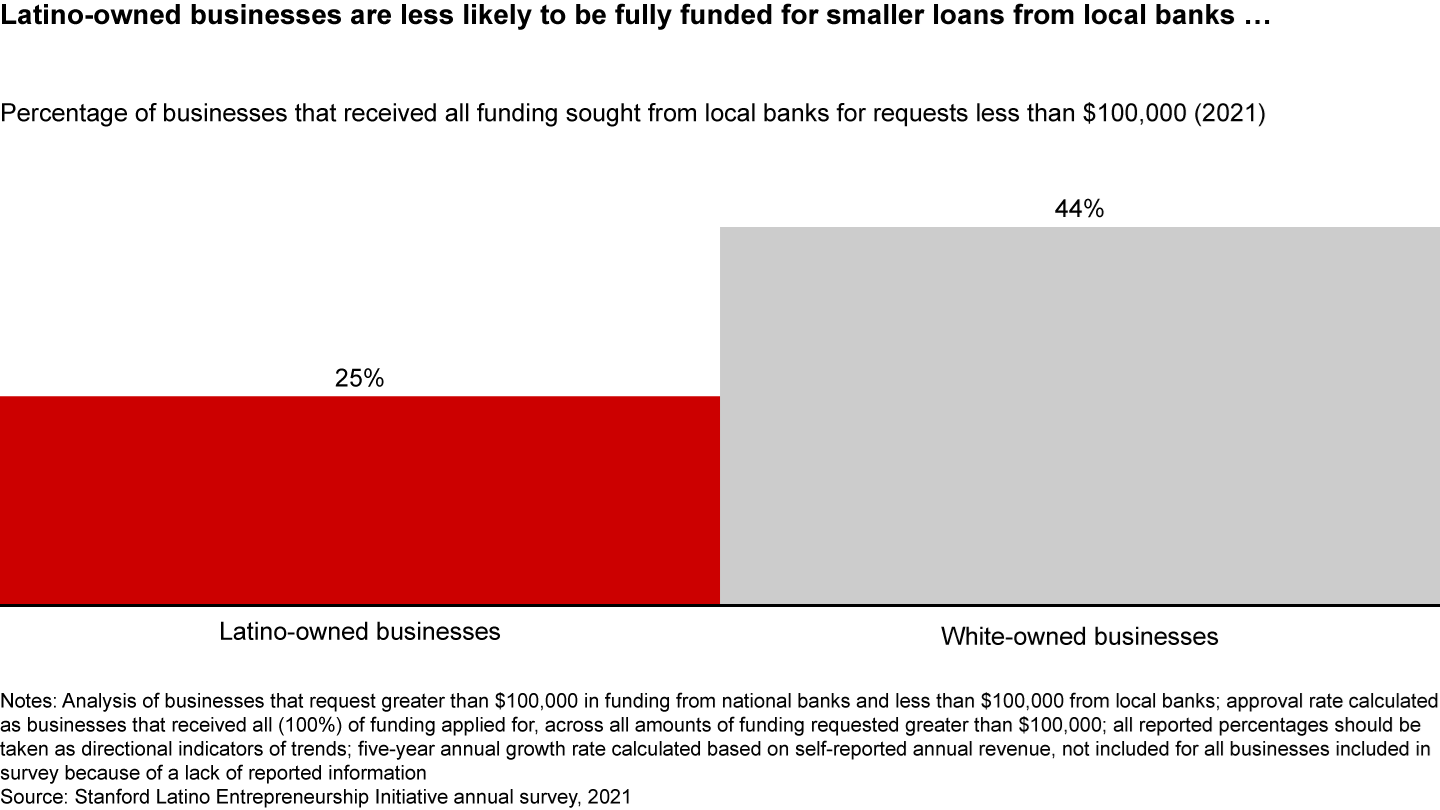
Latino-owned businesses are less likely to receive funding from national and local banks

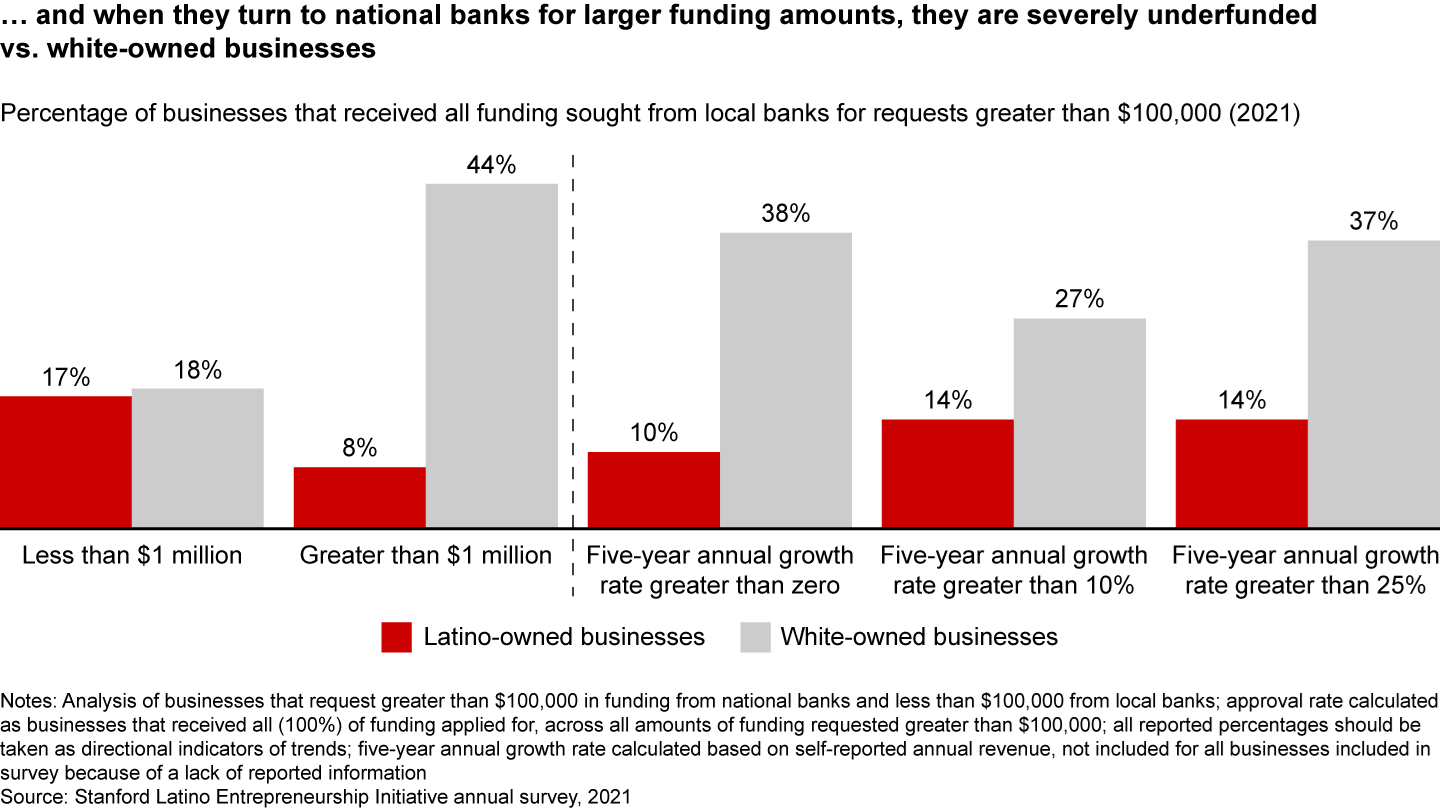
Though survey data does not fully explain why this gap exists, our research suggests that cultural expectations, language gaps, and loan approval processes can all play a role; some Latino business owners may struggle navigating the current structures and processes of the financing world and face challenges packaging a loan application or business data in ways likely to maximize the odds of being funded.
As a result, smaller employer LOBs (those with less than $1 million in revenue) are a full 19 percentage points less likely to be fully funded by local banks than comparable WOBs. LOBs are, in turn, forced to resort to less traditional sources of capital, relying on personal savings—smaller LOBs are 1.3 times more likely than WOBs to rely on personal savings and 1.4 times more likely to rely on family and friends to finance their businesses. They also turn more frequently to less stable sources of financing, such as grants or payday loans, and request five times more funding from hard-money lenders than WOBs. Not surprisingly, these sources of funding come with tougher terms, higher costs, and more risk, stunting LOBs’ growth (see Figure 4).
Small Latino-owned businesses with less than $1 million in revenue tend to rely on personal and higher-cost sources of capital

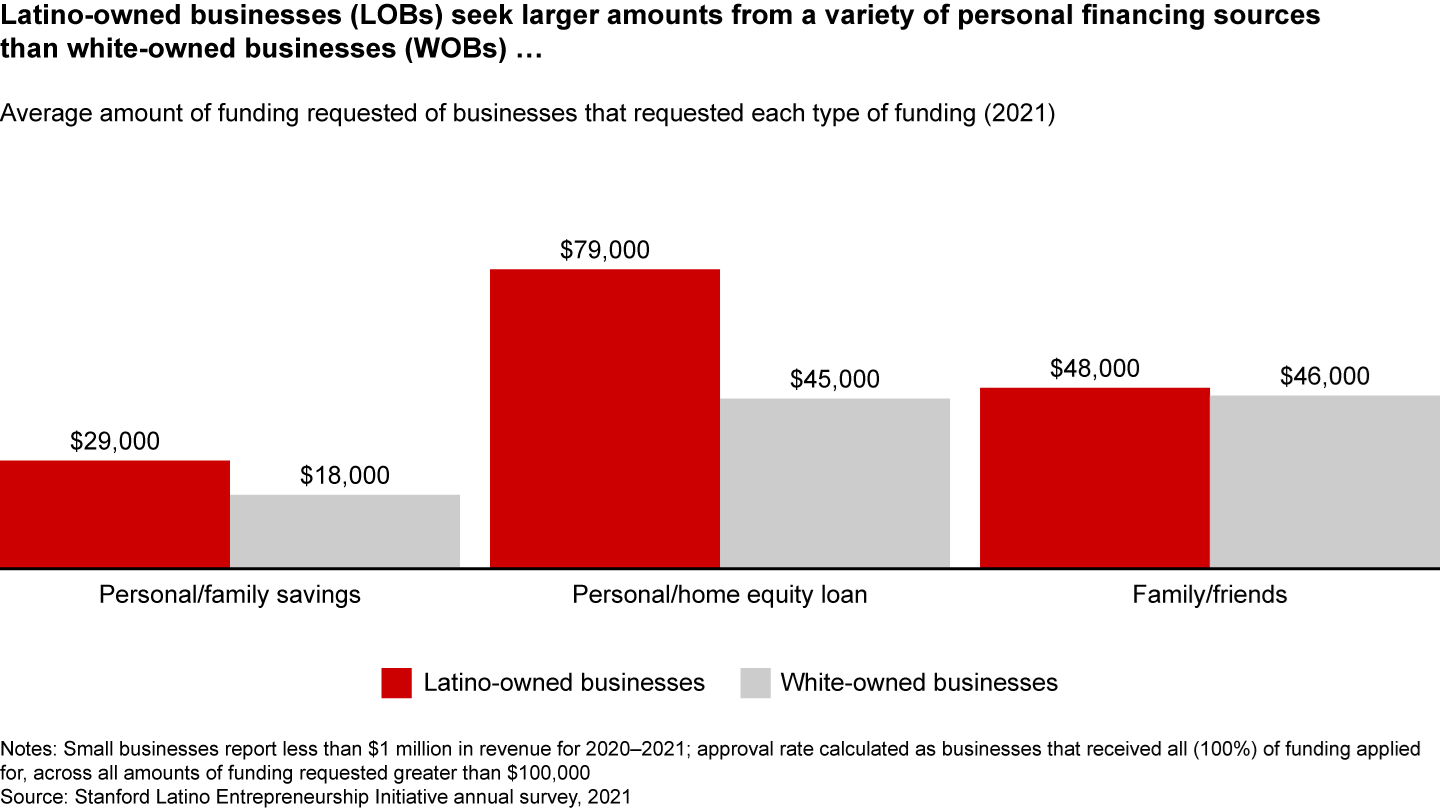
Small Latino-owned businesses with less than $1 million in revenue tend to rely on personal and higher-cost sources of capital

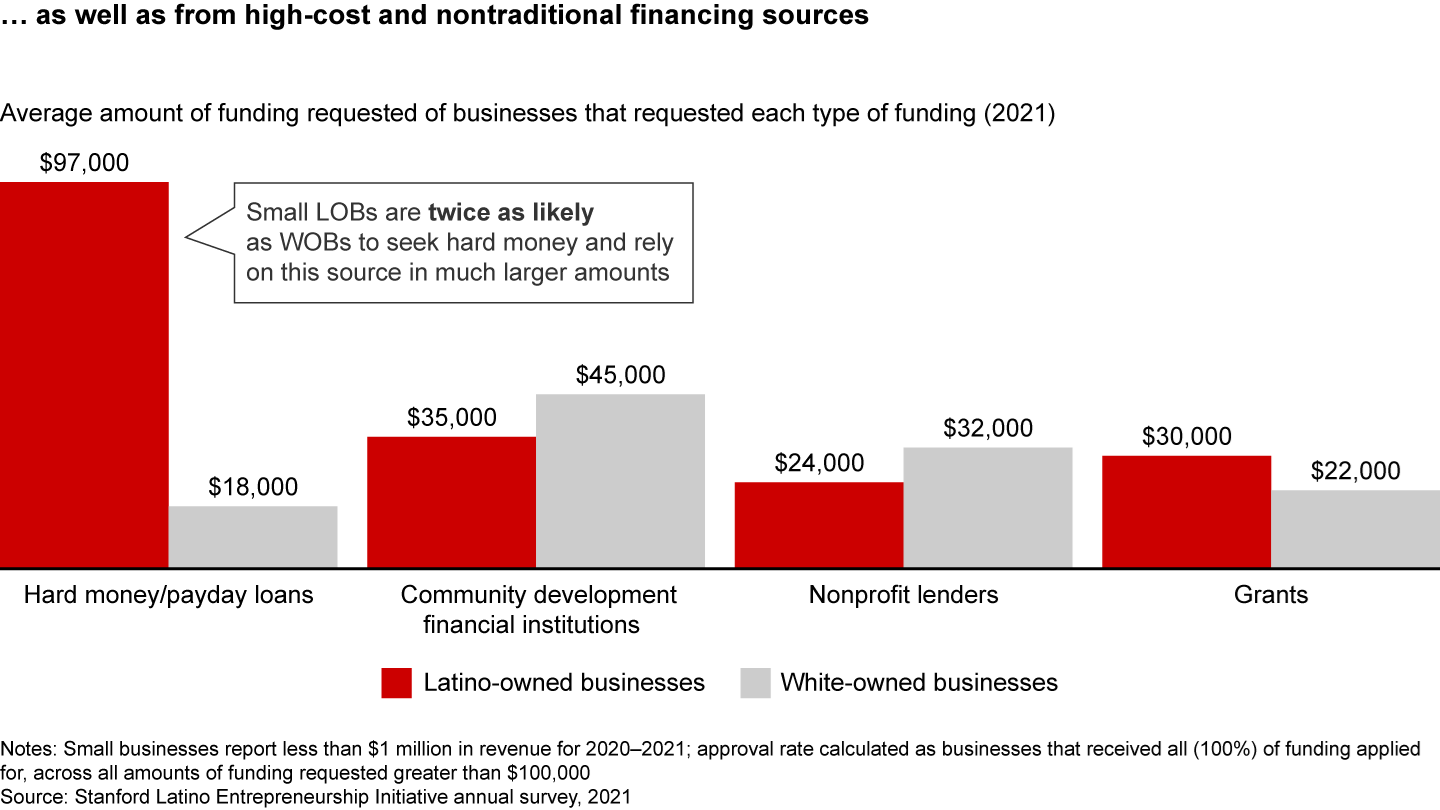
More mature employer LOBs (those with greater than $1 million in revenue) continue to experience disparities in their access to funding. At this stage, LOBs are 16 percentage points less likely to be fully funded by national banks compared with their white-owned peers. They are three times less likely to seek funding from angel investors—and those that do are nearly 30 percentage points less likely to have all their funding needs met (see Figure 5). Without reliable access to capital, mature LOBs continue to depend on sources of funding they have outgrown. They are 7 percentage points more likely to rely on personal credit cards to fund at this stage, and 6 percentage points more likely to rely on personal savings.
Mature Latino-owned businesses with greater than $1 million in revenue are much less likely to seek out and be fully funded by angel investors

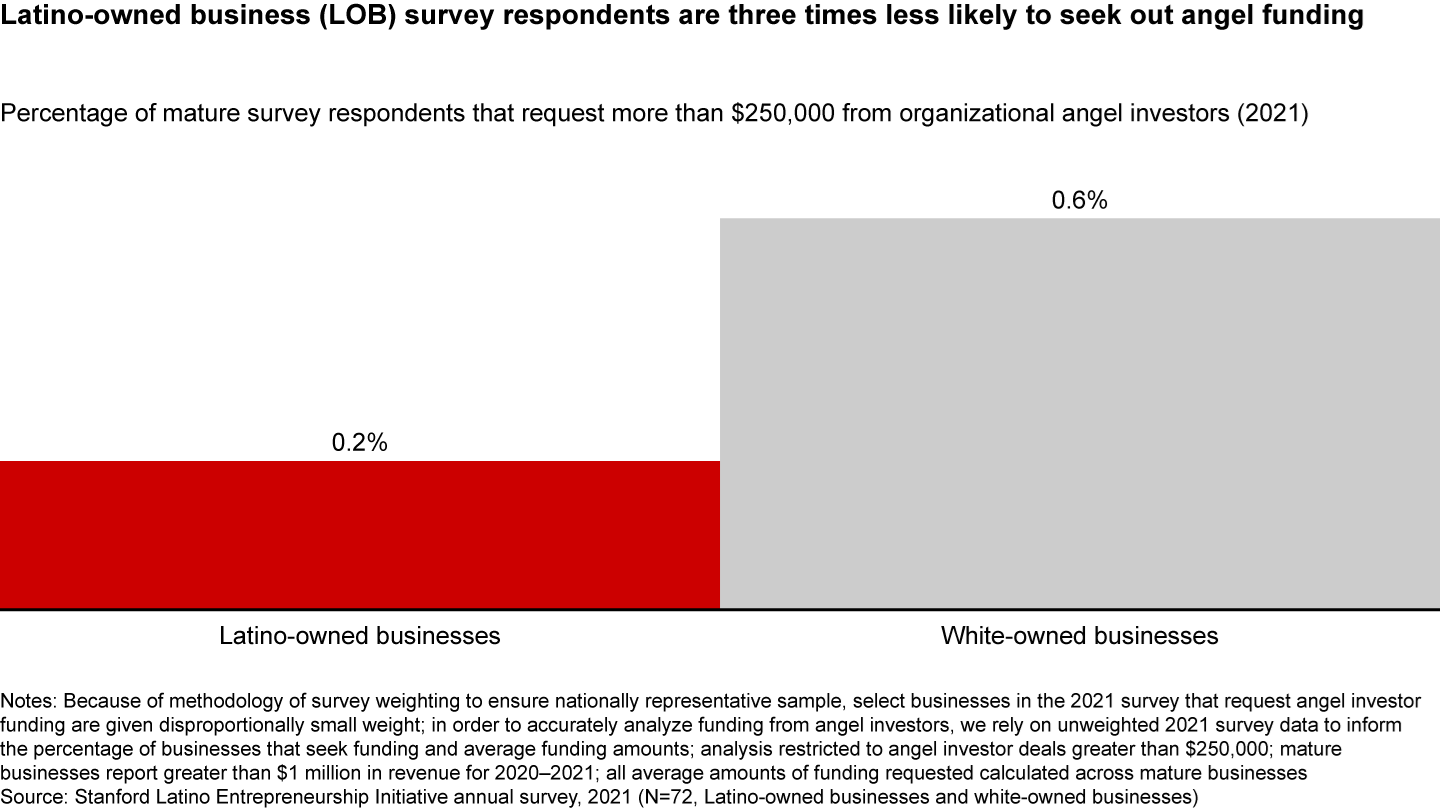
Mature Latino-owned businesses with greater than $1 million in revenue are much less likely to seek out and be fully funded by angel investors

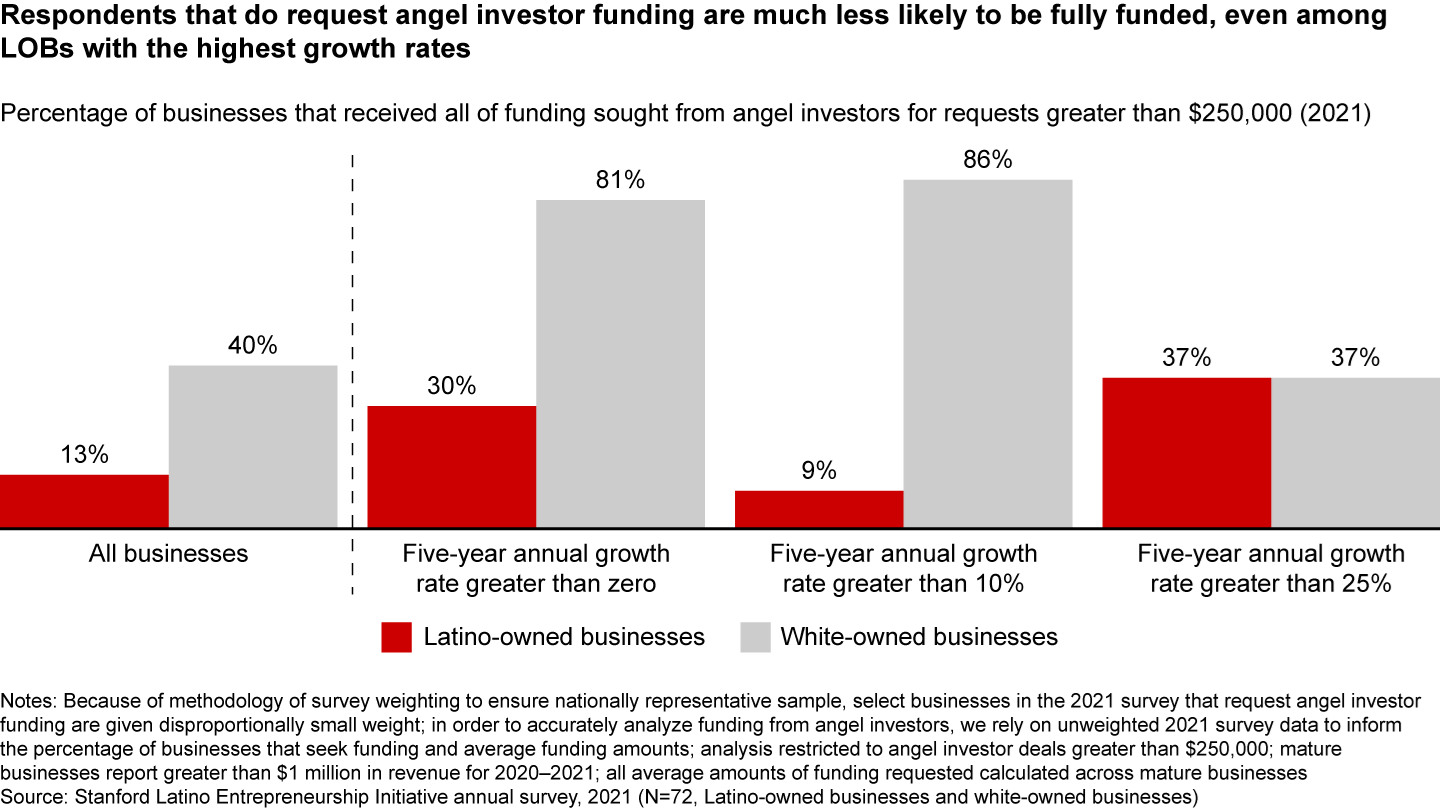
Scaling is not working for employer LOBs, especially as they mature and enter stages in which growth capital is most needed. The high cost of capital accessible to Latinos seems to play a role in depressing the profitability of LOBs right as they reach the $1 million revenue mark. Though they have similar profitability as WOBs at smaller sizes, by the time they reach $1 million to $5 million in revenue, only 53% of LOBs are profitable, compared with 63% of WOBs.
Because employer LOBs are stunted by the high cost of growth capital, they end up roughly half as likely as WOBs to make a pitch to a PE firm (see Figure 6); employer LOBs and WOBs, however, are comparably likely to be fully funded if they can get a seat at the table. When LOBs are able to make a successful pitch to VC or PE, they secure deals at similar rates to WOBs, but they get lower average valuations. According to Crunchbase data, the average valuation for Latino-owned businesses in 2020 was approximately $572 million, compared with $1.2 billion for nondiverse-owned businesses, though of course the size and profitability of these businesses is also a key factor.
Latino-owned businesses are less likely to have part of their business owned by private equity, venture capital, or angel investors

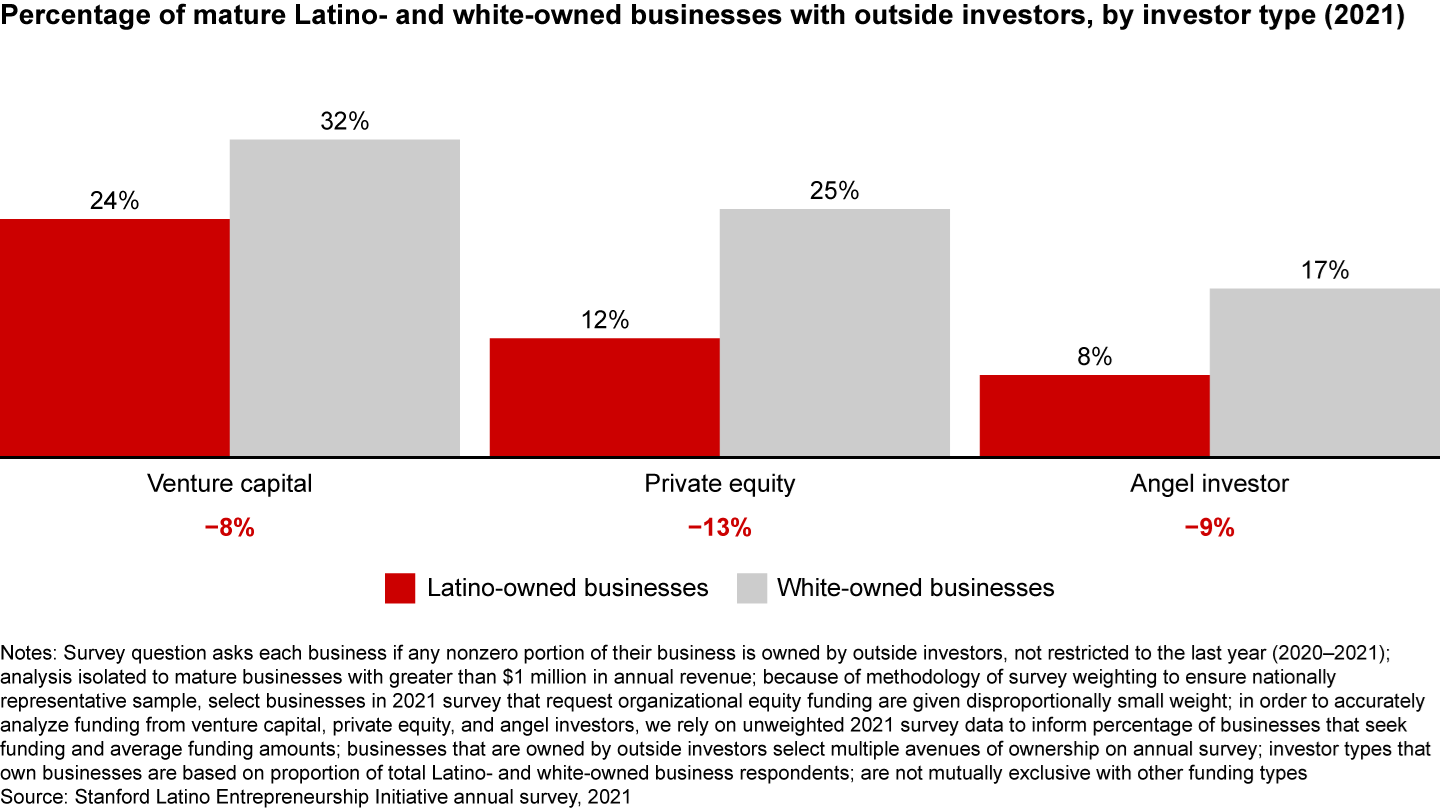
The few LOBs that have been well funded have shown enormous potential for investors. The average valuation of the VC- or PE-funded LOBs in Crunchbase’s Diversity Spotlight data set grew by approximately 30% (compared with just 12% for the non-Latino–owned peers) between 2010 and 2020, but these success stories are the exception to the rule. So far, based on the data that’s currently available, LOBs have reduced access to key stages of funding (see Figure 7): Less than 2% of deals in seed/angel, early-stage, and late-stage rounds go to Latino-owned businesses, according to Crunchbase data.
Latino-owned businesses are underrepresented at all funding rounds

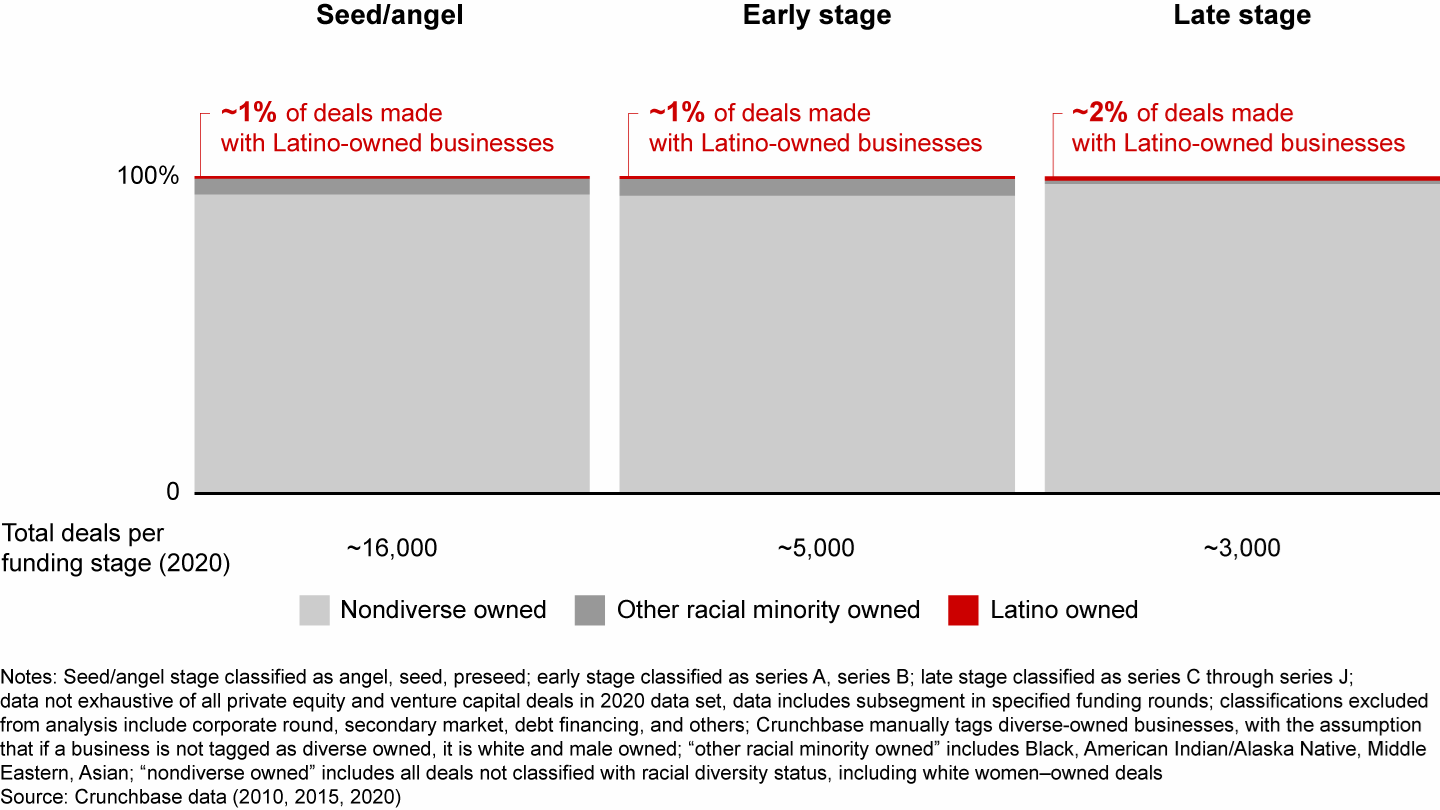
Even when LOBs do find backers, investors appear to be more cautious. LOBs are enrolling a larger pool of investors—twice as many, on average, in private equity—to get the same (or less) funding as their non-Latino peers (see Figure 8). WOBs receive more than three times as much funding per investor from private equity and nearly twice as much funding per investor from venture capital compared with LOBs. LOBs have received roughly 1% of all investments from the top 25 venture capital and private equity firms over the past decade. Latino-owned businesses made up less than 1% (approximately $680 million) of the $487 billion invested across the top 500 largest VC and PE deals in 2020.
Latino-owned businesses that secure private equity or venture capital funding source from about twice the number of investors, at lower levels of average funding per investor, than other businesses

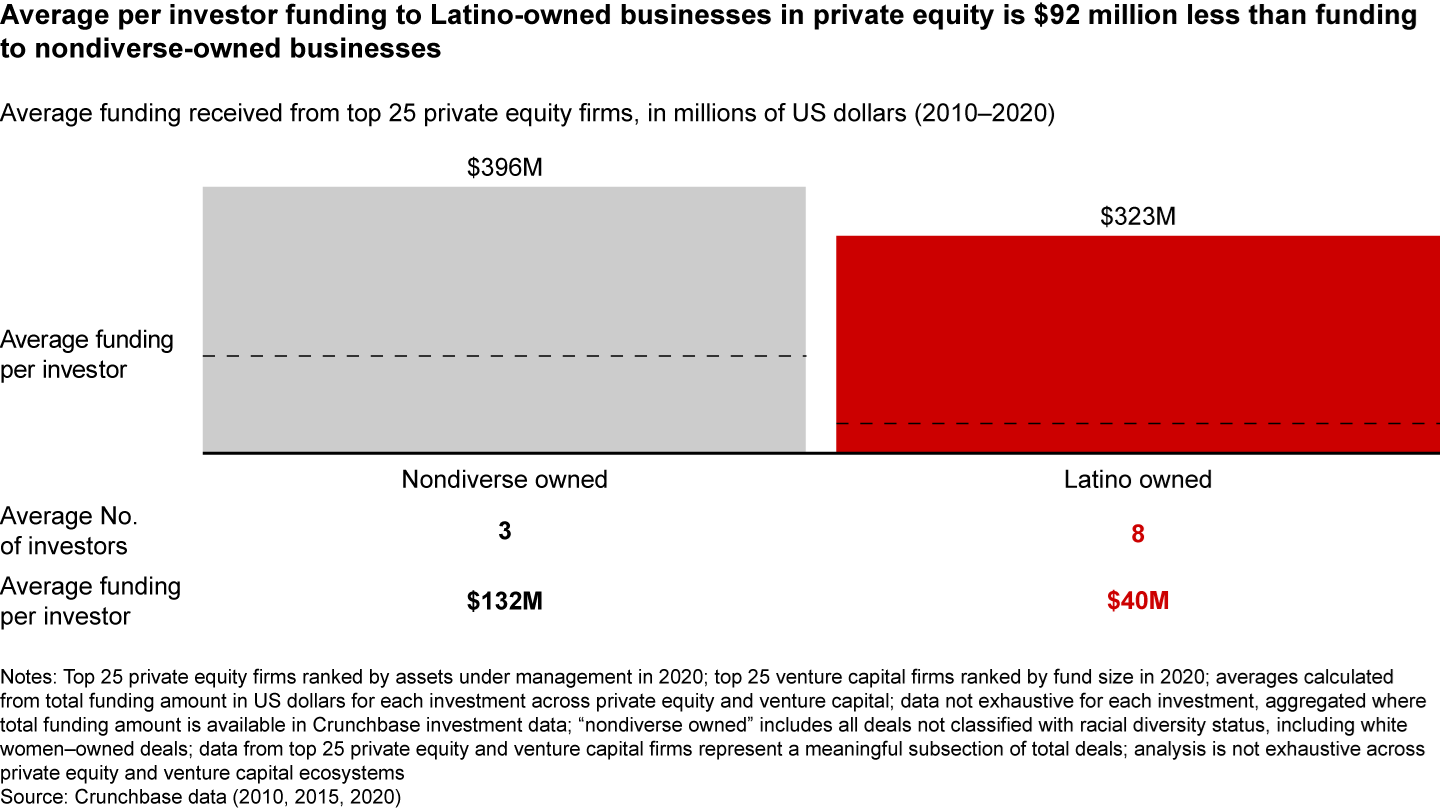
Latino-owned businesses that secure private equity or venture capital funding need to source about twice the number of investors, at lower levels of average funding per investor, than other businesses

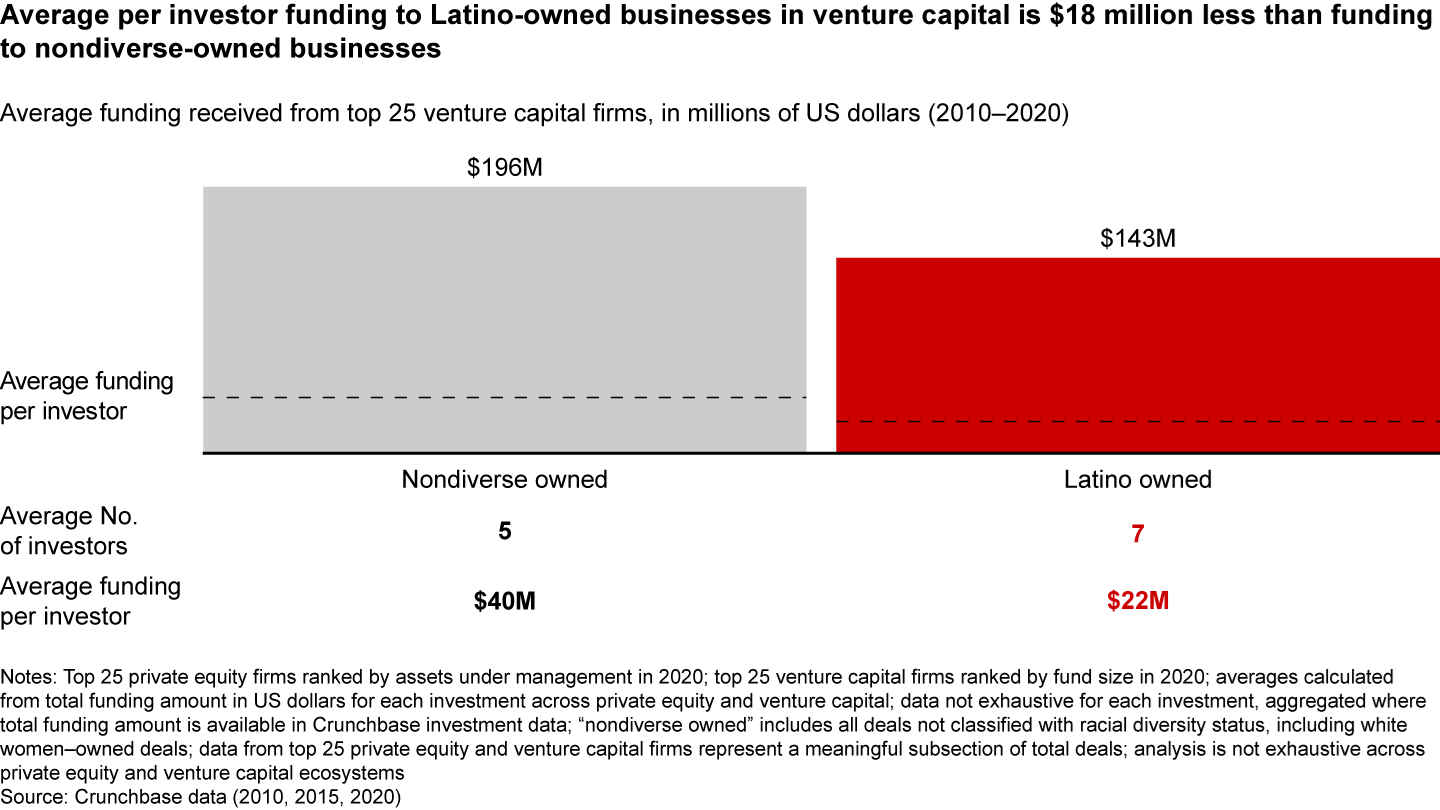
LOBs also struggle with a demand problem—providers of capital need to bring this segment of the economy into the tent
This is not a one-sided problem. Latino-owned businesses have historically not sought funding at anywhere near the same levels as their white-owned counterparts. Though Latino-owned businesses are more likely to apply for financing from banks than their white-owned peers, they are more tentative borrowers, seeking smaller amounts of funding from different sources. According to SLEI’s 2021 survey data, Latino owners of employer businesses who did not seek financing in 2021 were more than two times more likely to report that they did not know how to get it and three times more likely to report a bad past experience than white business owners.
Most Latino entrepreneurs in the US view their businesses as deeply personal endeavors. For the nearly 75% of employer LOBs that seek funding, compared with only 66% of employer WOBs, their most common source of capital is personal savings. Employer LOBs tend to rely most heavily on credit cards, personal bank loans, and loans from a family member or friend, according to SLEI’s 2021 survey data.
There may be good reason that they turn to friends and family for support: They’ve been burned too often in the past. Latino employer business owners report difficulty accessing credit to help manage cash flow or fund expenses related to expansion or procurement of new assets. SLEI’s 2019 State of Latino Entrepreneurship report describes the distinct challenges that LOBs face, including lengthy loan requirements and documentation. These LOBs, however, still get rejected more often and receive less than they request when compared with white-owned businesses.
Onerous requirements (or outright rejections) that LOBs have encountered from banks and other lenders for even simple loans or lines of credit have deterred healthy, growing businesses from seeking outside help to grow and shape the LOB landscape in significant ways that are different than their WOB peers.
A burning platform: What equity providers and lenders can do to close the gap
In this current state, far too much money is being left on the table. There is a real need for all links in the financial services value chain to adopt a test-and-learn approach to better serving these communities—while seeking returns. Across the board, we have identified a preliminary set of recommendations to drive progress.
- Equity is a catalyst; in terms of liquidity, it is a limited-constraint source of capital that allows small businesses to scale and meet their full potential.
- Small LOBs need new approaches from all investors that create access to equity funding. Entrepreneurs of all backgrounds commonly source funding through family, friends, and private investors. Equity funding can be the optimal way to grow small businesses so that they aren’t hamstrung by the need to service debt. But for LOBs, these sources of funding can run dry given existing wealth disparities and comparatively recent immigration. Banks, as well as angels, VC, and other equity sources, however, could open up the spigot by creating funds focused on helping bridge the gap and providing equity-based financing to new small businesses to help them grow and build a history that will open the doors to debt and larger equity institutional investors. Angel investors will be particularly well positioned to offer equity to high-potential small businesses.
- Institutional equity investors have an opportunity to help LOBs scale. There are many attractive and fast-growing LOBs—but they are less likely to be courted by angels, and less likely to reach the VC and PE investment stage. There is an opportunity for VC, PE, and other equity investors to bring expertise to help Latinos scale their businesses more efficiently and quickly when these businesses reach that stage.
- Other solutions, such as increased access to debt, innovative assessment models, and targeted education, will help narrow the funding gap.
- Debt lenders (banks and CDFIs) also have a role to play. Many segments have not fully taken advantage of lower-cost debt lending, or they may need to refinance to separate personal assets from their businesses. CDFIs and banks can partner together to help relay younger LOBs to help them get early access to capital—as well as help professionalizing and maturing into borrowing from banks.
- Renewed, clear credit assessment models are needed. Given that many of these LOBs are relatively new to debt financing or have faced rejection in the past, banks can simplify their credit models or look toward innovation (for instance, recommending LOBs use simple accounting software that estimates things like cash flow) to make the process easier/clearer.
- Suppliers can help solve the demand problem. Some LOB segments do not seek outside funding because of unfamiliarity with financing options; banks and CDFIs can partner to educate and market to LOBs on their funding options and the potential returns of using leverage to grow their businesses.
Segmentation provides a roadmap for investors to better target, assess, and support LOBs
Even if investors suddenly widen their aperture to include LOBs, today’s approaches will not easily bridge the mismatch with the LOB community. To start with, investors need to understand that there is, arguably, no single profile of a Latino-owned business. Similar to any other group, LOBs are a diverse group of businesses with very different risk profiles, needs, and approaches to growing their businesses.
The employer LOB market divides into six broad segments, each with a different history, profile, and approach to growth. In general terms, LOBs can be categorized by their overall scale and maturity—namely, less than or greater than $1 million in revenue. Within each of those two groupings, we have identified three distinct and actionable segments based on their funding behaviors, current capital structure, business growth, and overall business health. The solutions we’ve outlined above can make a material difference in helping employer LOBs access the funds they need to scale. But the best solutions vary across segments—as well as their existing behaviors accessing capital. LOBs are not one monolithic group, and neither are their capital needs.
Let’s break these down to explore the segments in more detail:
Some investors have seen—and are starting to seize—this enormous opportunity
The projections for the potential upside of the Latino-owned business market are not simply wishful thinking. Some pioneer investors have already recognized LOBs’ enormous potential and have tailored their practices and products to fund them. There are a mix of funders dipping a toe in this market.
- Latino-focused small business debt lenders: Some debt lenders, including Wells Fargo, Bank of America, and listo!, are beginning to offer Latino-oriented loans and outreach programs.
- Latino-owned and Latino-focused VC/PE firms and social impact–focused firms: This growing group of investors, including Camino Financial, Founders First, LiftFund, and others, see strong potential in providing capital to LOBs, and they are driving impact.
- VC/PE: Some VC and PE firms have an explicit Latino focus and are already moving to capture the strong returns LOBs can deliver, including Chingona, Leap Global Partners, and Palladium Equity Partners. These investors range from 50% to 97% of total investment in LOBs to date.
There are a handful of players driving investment in this space and they’re seeing great success so far. Among the more notable investors in these categories are LiftFund, a CDFI nonprofit focused on funding LOBs and providing wraparound services to support their growth (for example, consulting, education). Fifty-four percent of LiftFund’s clients are LOBs. They have helped multiple companies increase their workforces from zero and achieve other milestones. Their model has proven to accelerate business growth and drive broader economic impacts; this model could be considered by other investors.
Camino Financial is successfully redefining financial services practices to better suit Latino-owned businesses through alternative financing and machine learning. Camino has deployed approximately $30 million in small business loans and has supported LOBs to grow in multiple ways, including increasing their production capacity and operating income.
Leap Global Partners has been successful in growing LOBs through its capital investment. Leap’s ultimate mission is to develop and invest in Latino entrepreneurs; thus, nearly 97% of its total funding (constituting around 86% of its total deals) is allocated to LOBs. For example, Leap’s investment in Paystand helped the business-to-business payments company grow revenue 2.5 times year over year and drive a 240% increase in monthly subscriptions from 2017 to 2020.
Palladium Equity Partners also has a long and lucrative journey with LOB investment strategies. As a result of a deliberate decision to focus on the Hispanic market, 56% of its investments in fund rounds IV and V have been Hispanic oriented.
But this small group can’t support the full needs of the LOB community across all six of our segments. Properly understood, LOBs should be attractive investment opportunities for institutional investors of all types, including retail banks, CDFIs, VC, PE (for larger deals), and other equity sources. But understanding and targeting the distinct LOB segments will require a test-and-learn approach, new evaluation methods, and a creative mix of new products, such as revenue-based repayments, LOB outreach, education, and wraparound business support services.
A call to action for investors
The moment has come to recognize the potential of the Latino-owned business market. Taking into account the size of the opportunity and the success of the pioneers in this market, it’s time to do more. This is an opportunity to do well—and do good. The majority of these Latino entrepreneurs, often first-generation Americans, have built their businesses through their own hard work in spite of the disadvantages they face compared with their white peers. Ironically, even when they’re thriving along with growth, the path gets much rockier for LOBs as they approach the critical scale threshold, and a lack of affordable funding starts to make a material difference in their growth trajectory.
Funding the undercapitalized Latino-owned business market has the potential to provide great returns, not just for investors but for the Latino community and the country as a whole. LOBs could help fuel the economic engine for the US economy over the next decade—and provide a clear beacon of the power of capitalism, done right, to continue to supercharge growth, revitalize communities, and create access to opportunities for everyone.
Acknowledgements
Bain & Company gratefully acknowledges the substantial assistance of the Stanford Latino Entrepreneurship Initiative in the research for this report. We also appreciate the collaboration with the Latino Donor Collaborative and are pleased that this report will feature among the LDC 2021 reports on Latinos in the US economy.
